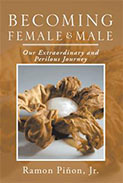
 |
This engrossing treatise on human reproduction, by Emeritus Professor of Biology at the University of California, Ramon Piñon, Jr, covers every aspect of human biological gender, as well as psychological, anthropological, and even mythological aspects. The book begins in the womb; the fetus destined to become a boy leaps ahead, showing his gender by Week 9, whereas the rather more cautious girl will be clearly female by Week 12. However, there are other significant determinants involved: If the mother smokes, uses drugs or has poor nutrition while pregnant, for example, this can cause later vulnerabilities in the new boy or girl. Puberty, stimulated by skeletal maturation and energy readiness, makes for even more complexities: If puberty happens too early, or too late, there can be negative consequences. Then, matured females and males start the whole thing over again, reproducing, which has its hazards, or avoiding reproducing, which also has its hazards, and finally experiencing loss of fertility, in the case of women, and in men, increase in impotence, until reproduction and all that goes with it ceases (except in the case of men, since even very old men are known to have fathered babies).
Becoming Female and Male is well organized and illustrated, written in a vocabulary accessible to the average person. It covers a vast amount of detailed material, including such issues as breastfeeding, abortion, in vitro fertilization, and sexual disorders. Behind the scientific data is the author’s general reminder of the incredible odds against, and the, some would say miraculous, nature of human conception: Human eggs are designed to self-destruct, sperm count in developed countries has been decreasing, and conception can only take place within a small window of time. As Piñon suggests, “every meeting of an egg and a sperm involves a rolling of the dice.” In a writing style both academic and philosophical, and with the facts clearly stated, this book invites us to consider our femaleness or maleness as part of “the gigantic genetic lottery.”
RECOMMENDED by the US Review